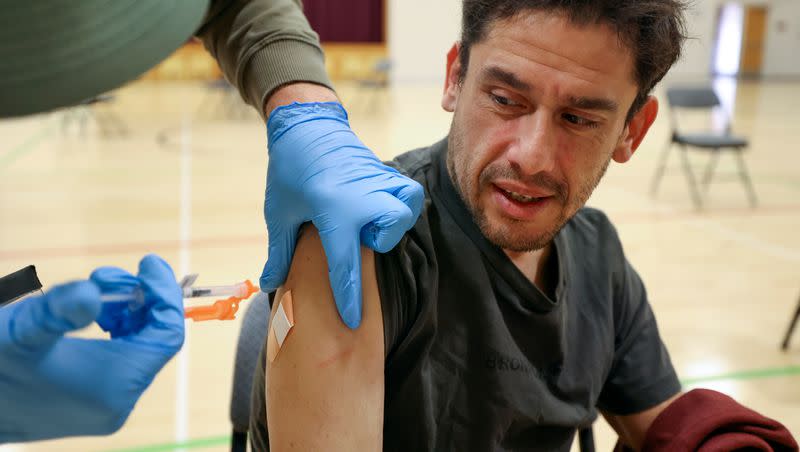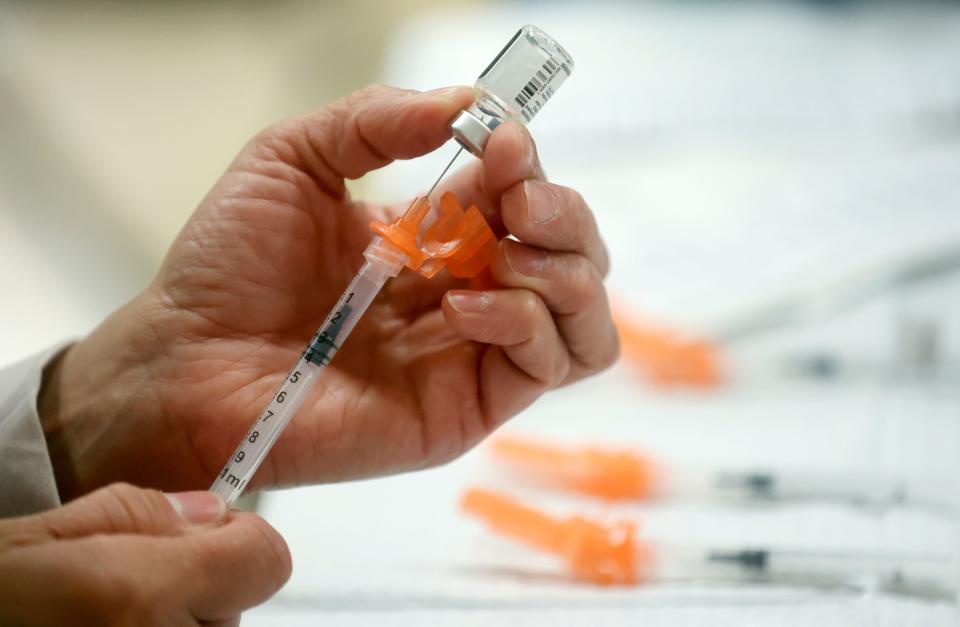The national emergency for COVID-19 is ending. What does that mean for Utahns?

Is it time to start treating COVID-19 like just another illness?
With U.S. emergency responses to the virus ending more than three years after the start of the pandemic, the Utah Department of Health and Human Services is set to stop reporting case counts next month, although other data will continue to be updated weekly.
“I think the indications are there. I’m hoping it’s true that we are getting to more where COVID is like flu, is like RSV (respiratory syncytial virus),” Dr. Leisha Nolen, the department’s state epidemiologist, said.
COVID-19 is still something that Utahns need to be aware of and taking precautions to prevent, Nolen said, advising that residents make sure they’re up-to-date on vaccinations against the virus and stay home when they’re sick.
“But I think we’re going to the point where it’s not a total game-changer and we have to disrupt our lives,” she said, adding that even though Utah did “pretty good” with the virus last winter, it still sent people to the hospital or worse.
“I don’t want people to totally say, ‘It’s done and we are never going to get another vaccine. We don’t need to worry about this at all.’ I think people should still get protected,” Nolen said, because immunity from the shots or prior infections does wane.
Related
The risk of developing long COVID-19, the term used to describe sometimes debilitating symptoms that linger for months and even years after being infected with the virus, is another reason for Utahns to do what they can to avoid getting sick, she said.

When more COVID-19 shots are coming
Dr. Tamara Sheffield, senior medical director for preventative medicine at Intermountain Health, the region’s largest health care system, also stressed the need for Utahns to make sure they’re current on their COVID-19 vaccinations.
“Staying up to date is the new concept and the best concept,” Sheffield said, as the U.S. moves to what will be an annual COVID-19 shot for most Americans. Just like yearly flu shots, the COVID-19 vaccine will be adjusted to fight the latest version of the virus.
“The vaccines will evolve as COVID keeps changing. So as we keep up to date with the newest vaccines, we will keep up with the best protection against the types of variants that are circulating at that time,” she said.
That’s what the most recent booster dose of vaccine does. Available since last fall, the updated shot is known as a bivalent booster because it targets versions of the omicron variant as well as the original strain of the virus.
For those who’ve had the bivalent booster shot, their next available dose likely won’t be until the fall, following an expected revision of the vaccine to go after whatever newer versions of the virus are then prevalent.
But less than 17% of all Americans — and just over 15% of all Utahns — have gotten the updated COVID-19 booster shot. Sheffield said it’s never too late to get vaccinated and boosted against COVID-19.
The shots are available to anyone 6 months and older, but vaccination rates are higher among older adults. There’s been some talk but no decision yet about offering an additional booster shot this spring to older and medically vulnerable Americans.
Since late January, the omicron subvariant labeled XBB.1.5 by scientists and also known as Kraken, after a mythical sea monster, has been dominant nationwide and in the region that includes Utah, according to the Centers for Disease Control and Prevention.
Kraken is now responsible for nearly all of the nation’s cases despite the emergence of other versions of the virus, including the CH.1.1 omicron subvariant also called Orthrus after the two-headed dog of Greek myths and described as “pretty nasty” by one Utah expert.
“Part of the reason we’ve had that stability, I think, is because we’ve had so many fewer cases,” Sheffield said. “So the fewer people there are to transmit a virus between themselves, the fewer potential there is for variants to form.”
It’s the emergence of new variants that caused huge COVID-19 surges in the past. The delta variant was responsible for Utah and the Intermountain West being the nation’s virus hotspot in the fall of 2021, and the omicron variant spread to record-breaking levels that winter.
Is COVID-19 now endemic?
Whether COVID-19 can be considered a seasonal illness remains to be seen. During the first two winters of the pandemic, flu and RSV largely disappeared thanks to masking and other measures the public was taking against COVID-19, but were part of this year’s “tripledemic.”
Han Kim, a public health professor at Westminster College in Salt Lake City, said more data is needed to determine if warmer temperatures make COVID-19 is less of a threat. Kim also isn’t ready to say the virus is endemic, meaning it’s considered under control.
“I think it’s still too early to know,” the professor said. “At the same time, from a public response standpoint, I think for a lot of people it’s done already. It’s been done for months,” while others are still taking precautions.
Everyone who’s sick should be staying home or wearing a mask, Kim said, along with keeping up with vaccinations against the virus, the simple precautions some already take to protect themselves and those around them from the flu or other endemic diseases.
There’s “no magic scientific formula” for determining a disease has shifted from pandemic to endemic, Kim said. The answer, he said, depends on how much illness and death society is willing to accept from a particular disease.
The prescribed precautions, which also include testing and extra caution for those at risk of severe disease because of age or medical conditions, aren’t too much to ask of the public, Kim said.
“I think we should pay attention until we’re certain about the pattern we’re seeing with COVID,” he said. “That doesn’t mean, oh, stay at home and shut everything down. Just pay attention to the numbers. Be careful. And be wary.”
Related
Too many people still see COVID-19 “in very binary terms,” Kim said. “It’s either shut everything down and impose a public health police state or basically go around as if we’re not at threat for any disease. Again, I think we need to really push for this middle ground.”

COVID-19 by the numbers
In Utah, there have been 1,095,398 COVID-19 cases reported since the pandemic began in early 2020, along with 42,753 hospitalizations and 5,341 deaths, according to state data last updated Friday.
Utah’s death toll from the virus increased by eight over the past week, including two boys between 1 and 14 years old. One of the boys was from Salt Lake County, the other from Utah County.
Nationwide, there have been 104,348,746 cases and 1,128,404 deaths from COVID-19, while more than 6.1 million Americans have been hospitalized with the virus, as of data posted Thursday by the U.S. Centers for Disease Control and Prevention.
Both Utah and the CDC are still tracking COVID-19 and reporting statistics including deaths, hospitalizations and vaccinations weekly. But many other entities, including Johns Hopkins University, stopped collecting COVID-19 data last month.
Earlier this week, President Joe Biden signed a bipartisan congressional resolution that ended the nation’s emergency’s response to COVID-19 earlier than he intended. A separate public health emergency is still set to remain in place until May 11.
The national emergency, first declared by then-President Donald Trump in March 2020, allowed the federal government to temporarily waive or modify some requirements related to Medicare, Medicaid and the state Children’s Health Insurance programs.
Related
Utah’s state epidemiologist said the federal changes are coming at a good time.
“Happily, these are expiring at a time when there is very low cases coming into the hospitals. There’s very little coming into our emergency rooms. Even our wastewater is looking pretty low,” Nolen said.
What’s changing in Utah?
Monitoring wastewater samples taken at treatment plants from around the state for the presence of COVID-19 is replacing case counts as a key indicator for the coronavirus, along with emergency room visits, she said.
She said case counts are being dropped from the state’s coronavirus.utah.gov website because they’ve become an even less accurate accounting of how many Utahns have the virus.
Home tests, which many people rely on to find out if they’re sick, aren’t reported to the state. Labs that process COVID-19 test results no longer have to report negative results, Nolen said, also ending the percent positivity calculation.
The state has been scaling back COVID-19 services since last April, when Gov. Spencer Cox shifted Utah to a “steady state” response to the virus, treating it like the flu or other endemic diseases.
“We have been planning and preparing for this for a long time,” said Kendra Babitz, assistant director of the Office of Emerging Infections in the health and human services department. “We’re a little bit ahead of other states in being more prepared for what this looks like.”
Babitz said when the Biden administration announced in January that the emergency orders were ending by May, Utah was already wrapping up mobile community testing. Free mass vaccination and treatment sites shut down last year.
She said the department is trying to encourage more health care providers to participate in a program offering uninsured patients access to tests and treatment that’s expected to remain in place through the middle of next year.
For most Utahns, the biggest difference they’ll see once the federal public health emergency is lifted will be how much they may now have to pay for COVID-19 tests, treatments and vaccines.
Babitz said Utahns should check with their insurance providers about what’s going to be covered after requirements that include getting up to eight free COVID-19 tests a month are no longer in place.
“A lot of this is still in flux,” she said, including what may yet happen with COVID-19.
“COVID is something people are ready to not think about any more and move beyond,” Babitz said. “But it’s still with us and still evolving even though we’re moving into more of an endemic state.”

